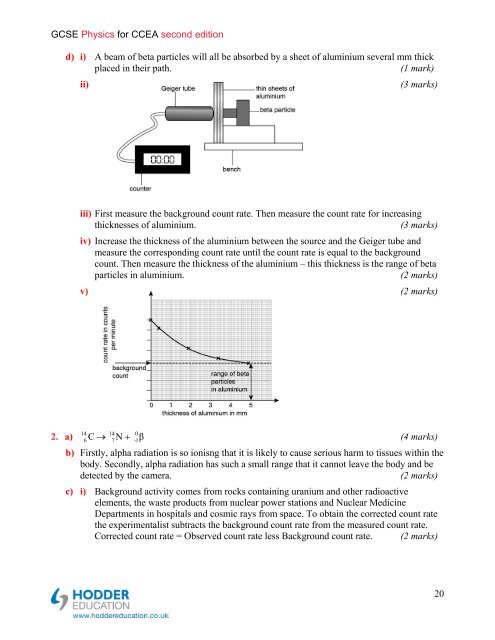Answers to questions in the Student Book - Hodder Plus Home
Answers to questions in the Student Book - Hodder Plus Home
Answers to questions in the Student Book - Hodder Plus Home
Create successful ePaper yourself
Turn your PDF publications into a flip-book with our unique Google optimized e-Paper software.
GCSE Physics for CCEA second editiond) i) A beam of beta particles will all be absorbed by a sheet of alum<strong>in</strong>ium several mm thickplaced <strong>in</strong> <strong>the</strong>ir path.(1 mark)ii)(3 marks)iii) First measure <strong>the</strong> background count rate. Then measure <strong>the</strong> count rate for <strong>in</strong>creas<strong>in</strong>gthicknesses of alum<strong>in</strong>ium.(3 marks)iv) Increase <strong>the</strong> thickness of <strong>the</strong> alum<strong>in</strong>ium between <strong>the</strong> source and <strong>the</strong> Geiger tube andmeasure <strong>the</strong> correspond<strong>in</strong>g count rate until <strong>the</strong> count rate is equal <strong>to</strong> <strong>the</strong> backgroundcount. Then measure <strong>the</strong> thickness of <strong>the</strong> alum<strong>in</strong>ium – this thickness is <strong>the</strong> range of betaparticles <strong>in</strong> alum<strong>in</strong>ium.(2 marks)v) (2 marks)14 14 02. a)6C 7N-1β(4 marks)b) Firstly, alpha radiation is so ionisng that it is likely <strong>to</strong> cause serious harm <strong>to</strong> tissues with<strong>in</strong> <strong>the</strong>body. Secondly, alpha radiation has such a small range that it cannot leave <strong>the</strong> body and bedetected by <strong>the</strong> camera.(2 marks)c) i) Background activity comes from rocks conta<strong>in</strong><strong>in</strong>g uranium and o<strong>the</strong>r radioactiveelements, <strong>the</strong> waste products from nuclear power stations and Nuclear Medic<strong>in</strong>eDepartments <strong>in</strong> hospitals and cosmic rays from space. To obta<strong>in</strong> <strong>the</strong> corrected count rate<strong>the</strong> experimentalist subtracts <strong>the</strong> background count rate from <strong>the</strong> measured count rate.Corrected count rate = Observed count rate less Background count rate. (2 marks)20
















